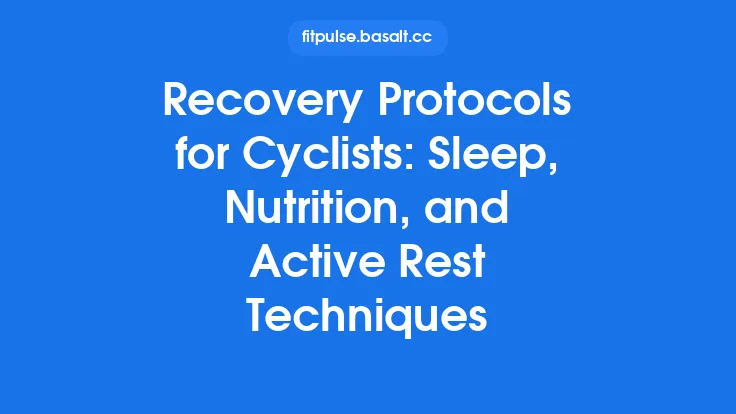Recovery after a hard training session or competition is a multifaceted process that goes far beyond simply resting. One of the most powerful, yet often under‑utilized, tools in an athlete’s arsenal is therapeutic massage. When applied correctly, massage can accelerate the removal of metabolic waste, restore optimal muscle length, calm the nervous system, and ultimately translate into better performance on the field, track, or gym. This article delves into the science behind massage, outlines the most effective techniques for muscle recovery, and provides practical guidance for integrating massage—both professional and self‑administered—into a comprehensive recovery strategy.
The Physiology of Massage: How It Supports Recovery
Circulatory Enhancement – Rhythmic pressure applied to soft tissue compresses veins and lymphatic vessels, propelling blood and lymph back toward the heart. This “muscle pump” effect increases oxygen delivery to fatigued fibers while facilitating the clearance of lactate, carbon dioxide, and inflammatory mediators.
Fascial Remodeling – The connective tissue network that surrounds muscle (fascia) can become stiff or develop adhesions after repetitive loading. Mechanical loading through massage temporarily disrupts these cross‑links, allowing the fascia to regain its pliability and transmit forces more efficiently.
Neuromodulation – Massage stimulates mechanoreceptors (e.g., Ruffini endings, Pacinian corpuscles) that send afferent signals to the spinal cord and brain. This input can inhibit nociceptive (pain) pathways via the gate‑control theory and promote the release of endogenous opioids, reducing perceived soreness.
Autonomic Balance – A sustained, moderate‑intensity massage shifts the autonomic nervous system toward parasympathetic dominance. The resulting drop in heart rate and cortisol levels creates an anabolic environment conducive to tissue repair.
Cellular Signaling – Mechanical deformation of muscle fibers triggers mechanotransduction pathways that up‑regulate nitric oxide synthase and growth factors such as IGF‑1, supporting protein synthesis and satellite cell activation.
Core Massage Techniques for Athletes
Effleurage (Gliding Strokes)
A foundational technique involving long, sweeping strokes performed with the palms, fingers, or forearms. Effleurage warms the tissue, encourages superficial blood flow, and prepares deeper work. For recovery, use moderate pressure and follow the direction of muscle fibers, covering the entire length of the target muscle.
Petrissage (Kneading)
This technique lifts, rolls, and squeezes the muscle, targeting deeper layers. Petrissage helps break up localized congestion, improves tissue elasticity, and promotes fluid exchange between intracellular and extracellular spaces. Apply a rhythmic, alternating pressure that mimics a gentle “kneading” motion.
Friction (Cross‑Fibre)
Short, deep, transverse strokes applied across the grain of the muscle fibers. Friction is valuable for addressing localized tight spots or minor scar tissue without delving into the full scope of trigger‑point therapy. Use the fingertips or thumb, maintaining steady pressure for 10–15 seconds per spot before moving.
Tapotement (Percussive Strokes)
A series of rapid, rhythmic taps performed with the edge of the hand, cupped hands, or fingertips. Tapotement stimulates the muscle spindle, enhancing neuromuscular activation and providing a “wake‑up” effect that can be useful after prolonged low‑intensity work.
Compression & Hold
Steady, sustained pressure applied directly over a muscle belly or tendon for 30–60 seconds. This technique encourages a reflexive relaxation response, reduces muscle tone, and can be especially effective for large muscle groups such as the quadriceps or hamstrings.
Stretch‑Assisted Massage
Combining a gentle stretch with simultaneous massage (often using effleurage or petrissage) lengthens the muscle while the soft tissue is being mobilized. This synergistic approach improves extensibility and can be incorporated at the end of a session to reinforce range of motion gains.
Deep Tissue and Sports‑Specific Massage
Deep tissue massage (DTM) employs higher pressure and slower strokes to reach the deeper fascia and muscle layers. For athletes, DTM is most beneficial when:
- Targeting chronic tightness that persists despite regular recovery modalities.
- Preparing for high‑intensity competition by breaking down adhesions that limit force transmission.
A typical DTM protocol for a lower‑body athlete might include:
- Effleurage (2–3 minutes) to warm the area.
- Petrissage (3–4 minutes) focusing on the gluteal and hamstring complexes.
- Friction (2 minutes per identified tight spot).
- Compression & Hold (1 minute per major muscle group).
Sports‑specific massage adapts these techniques to the demands of a particular discipline. For example, a sprinter may receive concentrated work on the hip flexors, adductors, and calf complex, while a swimmer might focus on the latissimus dorsi, rotator cuff, and thoracic extensors.
Lymphatic Drainage Massage for Reducing Swelling
Although often associated with post‑surgical care, manual lymphatic drainage (MLD) is a gentle, rhythmical technique that encourages lymph flow without compressing the underlying muscles. By using light, superficial strokes that follow the natural lymphatic pathways, MLD can:
- Decrease interstitial fluid accumulation after intense training or minor injuries.
- Reduce delayed‑onset muscle soreness (DOMS) by clearing inflammatory metabolites.
The practitioner typically works from proximal to distal, beginning near the clavicular nodes and moving toward the extremities, using a “milking” motion with minimal pressure.
Neuromuscular Effects: Modulating Pain and Muscle Tone
Massage influences the neuromuscular system through several mechanisms:
- Presynaptic Inhibition – Mechanical stimulation reduces the release of excitatory neurotransmitters at the neuromuscular junction, lowering muscle spindle firing rates.
- Gamma Motor Neuron Modulation – By altering gamma drive, massage can decrease baseline muscle tone, making fibers more receptive to subsequent activation.
- Pain Gate Activation – The stimulation of large‑diameter afferent fibers (A‑β) overrides the transmission of nociceptive signals (A‑δ and C fibers), providing an immediate analgesic effect.
These neuromodulatory actions not only alleviate soreness but also improve proprioceptive acuity, which is critical for technical sports performance.
Implementing Massage in a Recovery Plan
Frequency and Duration
- General Maintenance – 1–2 sessions per week, each lasting 30–45 minutes, are sufficient for most athletes.
- Intensive Training Blocks – Increase to 3–4 sessions per week, focusing on 15–20 minutes per targeted muscle group to avoid overstimulation.
Choosing Between Professional and Self‑Massage
- Professional Massage offers skilled pressure modulation, comprehensive assessment, and the ability to address complex patterns that may be difficult to self‑administer.
- Self‑Massage provides flexibility and can be performed daily, especially for areas that require frequent attention (e.g., calves, forearms).
A hybrid approach—regular professional sessions supplemented with brief self‑massage—often yields the best balance of depth and consistency.
Practical Self‑Massage Strategies
Hand Techniques
- Palm Glide – Place the palm on the muscle belly and slide it slowly toward the tendon, applying moderate pressure.
- Finger Knead – Use the thumb and opposite fingers to encircle a muscle, gently squeezing and releasing.
- Thumb Press – For localized tightness, press the thumb into the spot, hold for 10–15 seconds, then release.
Simple Tools (Brief Overview)
While the focus remains on manual techniques, a few low‑tech aids can enhance self‑massage: a smooth, medium‑density massage ball for pinpoint pressure, a wooden stick for linear strokes along the forearm, or a soft roller for broad, gentle effleurage. These tools should complement, not replace, hand work.
Safety Considerations and Contra‑Indications
- Acute Inflammation – Avoid deep pressure on inflamed tissues; opt for light effleurage and lymphatic techniques.
- Open Wounds or Skin Infections – Do not massage over compromised skin.
- Thrombosis Risk – Individuals with known clotting disorders should seek medical clearance before deep tissue work.
- Pregnancy – Certain positions and abdominal massage are contraindicated; focus on the upper back, shoulders, and legs with modified pressure.
Always communicate any discomfort to the therapist and adjust pressure accordingly. For self‑massage, stop immediately if sharp pain occurs.
Monitoring Progress and Adjusting Techniques
- Subjective Measures – Track perceived soreness (e.g., on a 0–10 scale) before and after each session.
- Objective Metrics – Use range‑of‑motion tests, muscle strength assessments, or performance markers (e.g., sprint time) to gauge functional improvements.
- Adaptation – As tissue tolerance improves, gradually increase pressure or duration, but maintain a balance to prevent over‑loading the nervous system.
Regular reassessment ensures that massage remains a targeted, effective component of the recovery toolbox.
Summary of Key Takeaways
- Massage accelerates recovery by enhancing circulation, remodeling fascia, modulating pain pathways, and promoting a parasympathetic state.
- Core techniques—effleurage, petrissage, friction, tapotement, compression, and stretch‑assisted massage—address different layers and objectives.
- Deep tissue and sports‑specific massage provide targeted relief for chronic tightness and sport‑related demands.
- Lymphatic drainage can mitigate swelling and reduce DOMS without heavy pressure.
- Neuromuscular effects of massage improve muscle tone regulation and proprioception, directly supporting performance.
- A balanced program combines regular professional sessions with daily self‑massage, tailored to training load and individual response.
- Safety, proper technique, and ongoing monitoring are essential to maximize benefits and avoid adverse effects.
By integrating these evidence‑based massage techniques into a structured recovery regimen, athletes can shorten downtime, enhance muscle function, and unlock higher levels of performance.





